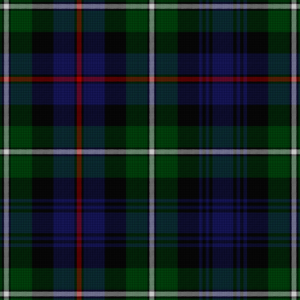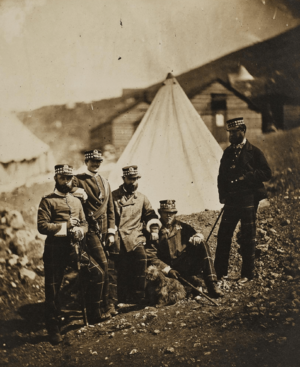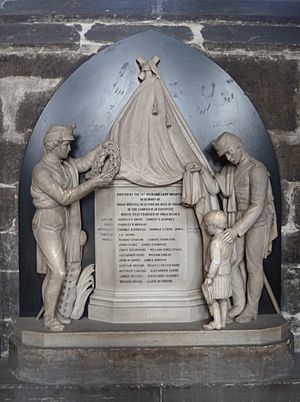71st (Highland) Regiment of Foot facts for kids
The 71st Regiment of Foot was a famous Scottish Highland army group in the British Army. It was started in 1777. Later, in 1881, it joined with another regiment, the 74th (Highland) Regiment of Foot, to become the 1st Battalion of the Highland Light Infantry.
Quick facts for kids 71st Regiment of Foot |
|
|---|---|
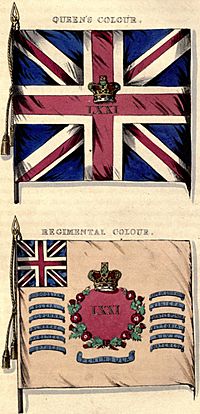
Regimental colours
|
|
| Active | 19 December 1777 – 1 July 1881 |
| Country | |
| Branch | |
| Type | Infantry |
| Role | Light infantry |
| Size | One battalion (two battalions 1778–1783, 1804–1815) |
| Garrison/HQ | Cameron Barracks, Inverness |
| Nickname(s) | The Assaye Regiment |
| Engagements | Second Anglo-Mysore War Third Anglo-Mysore War French Revolutionary Wars Napoleonic Wars Crimean War Indian Rebellion Ambela Campaign |
Contents
History of the 71st Regiment
How the Regiment Started
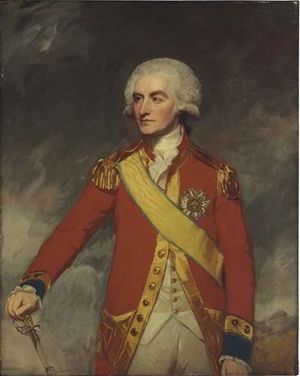
The 71st Regiment was first formed in December 1777 in Elgin, Moray, Scotland. It was created by Major-General John Mackenzie, Lord MacLeod. At first, it was called the 73rd (Highland) Regiment of Foot (McLeod's Highlanders). Its soldiers were from Highland clans.
A second group, called a battalion, was added in September 1778. The first battalion traveled to India in January 1779. On the way, they stopped at Gorée in Senegal. They arrived in Madras (now Chennai) in January 1780.
During the Second Anglo-Mysore War, some of their soldiers were captured in September 1780. The battalion then fought in several battles, including the Battle of Porto Novo in July 1781 and the Battle of Sholinghur in September 1781. They also helped in the siege of Cuddalore in June 1783.
Meanwhile, the second battalion went to the Mediterranean Sea. They served as marines (soldiers who fight on ships) at the Battle of Cape St. Vincent in January 1780. They then landed at Gibraltar and took part in the Great Siege of Gibraltar. This second battalion was later disbanded in 1783.
In 1786, the regiment changed its name to the 71st (Highland) Regiment of Foot (MacLeod's Highlanders). They fought in the siege of Seringapatam in February 1792 during the Third Anglo-Mysore War.
Fighting in the Napoleonic Wars
The regiment stayed in India and fought in the siege of Pondicherry in August 1793 during the French Revolutionary Wars. After that, they moved to Ceylon in August 1795 and returned to Scotland in August 1798.
Another second battalion was formed in October 1804, but it stayed in Scotland. The first battalion went to the Cape of Good Hope in August 1805. They fought in the Battle of Blaauwberg in January 1806.
Next, the battalion sailed to South America. They were part of a difficult mission against Buenos Aires. During this mission, the battalion was captured, and their special flags (called Regimental Colours) were taken. New flags were given to the regiment in April 1808.
The first battalion was rebuilt and sent to Portugal in June 1808 for the Peninsular War. This was a big war in Spain and Portugal. The regiment was renamed the 71st (Glasgow Highland) Regiment of Foot that same month. They fought in battles like Battle of Roliça and Battle of Vimeiro in August 1808, and the Battle of Corunna in January 1809. After these battles, they left the Peninsula.
In March 1809, they became a light infantry regiment, which means they were trained to move quickly. They then took part in the difficult Walcheren Campaign in autumn 1809. They returned home and were renamed the 71st (Highland) Regiment of Foot (Light Infantry) in spring 1810.
The regiment went back to the Peninsula in September 1810. They fought in many important battles, including:
- Battle of Fuentes de Oñoro in May 1811
- Battle of Arroyo dos Molinos in October 1811
- Battle of Almaraz in May 1812
- Battle of Vitoria in June 1813
They then chased the French army into France. They fought in the Battle of the Pyrenees in July 1813, the Battle of Nivelle in November 1813, and the Battle of the Nive in December 1813. They also fought at the Battle of Orthez in February 1814 and the Battle of Toulouse in April 1814.
The battalion returned home in July 1814. In April 1815, they went to Ostend. They were part of the 3rd Brigade and fought bravely at the famous Battle of Waterloo in June 1815.
The Victorian Era and Beyond
In May 1824, the regiment traveled to Canada. They then moved to Bermuda in October 1831 before returning to England in September 1834. They went back to Canada in April 1838 and then to Antigua in December 1844. They finally returned home in January 1847.
In 1853, the regiment went to Corfu. Then, they landed in the Crimea to fight in the Crimean War. They were involved in the siege of Sevastopol in the winter of 1854.
The regiment then went to India to help stop the Indian Rebellion in 1857. They stayed there for the Ambela Campaign in 1863. The regiment returned home in 1865. They then went to Gibraltar in 1868 before coming home again in 1880.
In the 1870s, there were changes in the British Army called the Cardwell Reforms. These reforms linked single-battalion regiments together. The 71st Regiment was linked with the 78th (Highlanders) Regiment of Foot. They shared a training center in Inverness.
On July 1, 1881, more changes happened with the Childers Reforms. The 71st Regiment joined with the 74th (Highland) Regiment of Foot. Together, they formed the 1st and 2nd Battalions of the Highland Light Infantry. This marked the end of the 71st Regiment as a separate unit.
Battle Honours
Battle honours are special awards given to regiments for their bravery and success in battles. The 71st Regiment received honours for these important battles:
- Hindoostan
- Cape of Good Hope 1806
- Peninsular War: Rolica, Vimiera, Corunna, Fuentes d'Onor, Almaraz, Vittoria, Pyrenees, Nive, Orthes, Peninsula
- Napoleonic Wars: Waterloo
- Crimean War: Sevastopol
- Central India
See also


